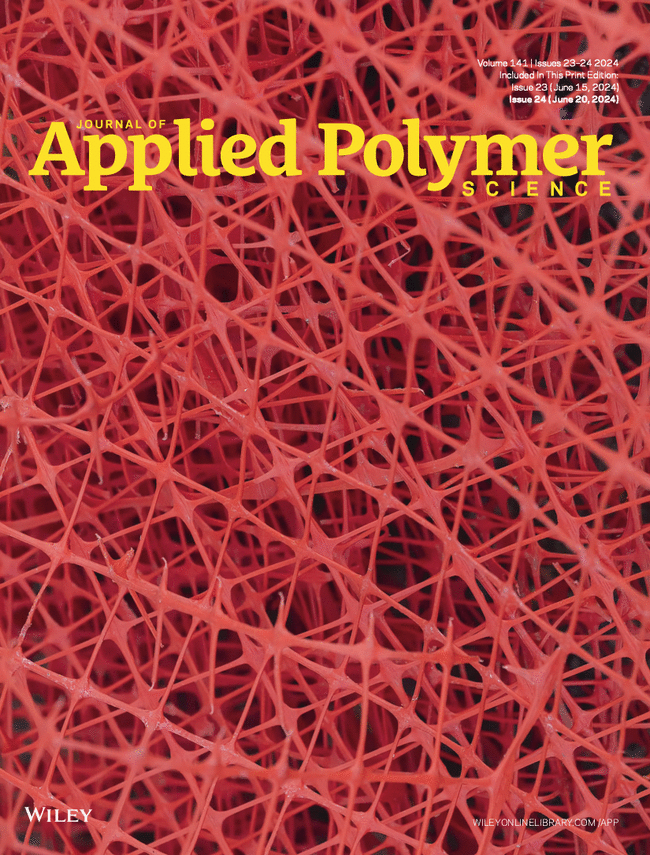Yasutomo Noishiki, Yoshiharu Nishiyama, Masahisa Wada, Shigenori Kuga, Jun Magoshi
下载PDF
{"title":"Mechanical properties of silk fibroin–microcrystalline cellulose composite films","authors":"Yasutomo Noishiki, Yoshiharu Nishiyama, Masahisa Wada, Shigenori Kuga, Jun Magoshi","doi":"10.1002/app.11370","DOIUrl":null,"url":null,"abstract":"<p>Silk fibroin–microcrystalline cellulose (cellulose whisker) composite films with varied compositions were prepared by casting mixed aqueous solution/suspensions of the two components. Silk fibroin was dissolved in 10<i>M</i> LiSCN followed by dialysis; a cellulose whisker suspension was prepared by sulfuric acid hydrolysis of tunicate cellulose. Macroscopically homogeneous films were obtained at all mixing ratios. While the Young's modulus of the composite films showed a linear, additive dependence on the mixing ratio, the tensile strength and ultimate strain showed a maximum at a 70–80% cellulose content, reaching five times those of fibroin-alone or cellulose-alone films. At the same mixing ratio, infrared spectra of the composite films showed a shift of the amide I peak from 1654 to 1625 cm<sup>−1</sup>, indicating the conformational change of fibroin from a random coil to a β structure (silk II) at the whisker–matrix interface. This change seems to be induced by contact of fibroin molecules with a highly ordered surface of cellulose whisker. © 2002 Wiley Periodicals, Inc. J Appl Polym Sci 86: 3425–3429, 2002</p>","PeriodicalId":183,"journal":{"name":"Journal of Applied Polymer Science","volume":"86 13","pages":"3425-3429"},"PeriodicalIF":2.7000,"publicationDate":"2002-10-09","publicationTypes":"Journal Article","fieldsOfStudy":null,"isOpenAccess":false,"openAccessPdf":"https://sci-hub-pdf.com/10.1002/app.11370","citationCount":"150","resultStr":null,"platform":"Semanticscholar","paperid":null,"PeriodicalName":"Journal of Applied Polymer Science","FirstCategoryId":"92","ListUrlMain":"https://onlinelibrary.wiley.com/doi/10.1002/app.11370","RegionNum":3,"RegionCategory":"化学","ArticlePicture":[],"TitleCN":null,"AbstractTextCN":null,"PMCID":null,"EPubDate":"","PubModel":"","JCR":"Q2","JCRName":"POLYMER SCIENCE","Score":null,"Total":0}
引用次数: 150
引用
批量引用
Abstract
Silk fibroin–microcrystalline cellulose (cellulose whisker) composite films with varied compositions were prepared by casting mixed aqueous solution/suspensions of the two components. Silk fibroin was dissolved in 10M LiSCN followed by dialysis; a cellulose whisker suspension was prepared by sulfuric acid hydrolysis of tunicate cellulose. Macroscopically homogeneous films were obtained at all mixing ratios. While the Young's modulus of the composite films showed a linear, additive dependence on the mixing ratio, the tensile strength and ultimate strain showed a maximum at a 70–80% cellulose content, reaching five times those of fibroin-alone or cellulose-alone films. At the same mixing ratio, infrared spectra of the composite films showed a shift of the amide I peak from 1654 to 1625 cm−1 , indicating the conformational change of fibroin from a random coil to a β structure (silk II) at the whisker–matrix interface. This change seems to be induced by contact of fibroin molecules with a highly ordered surface of cellulose whisker. © 2002 Wiley Periodicals, Inc. J Appl Polym Sci 86: 3425–3429, 2002
丝素-微晶纤维素复合膜的力学性能
通过浇铸两种组分的混合水溶液/悬浮液,制备了不同组分的丝素-微晶纤维素(纤维素须)复合膜。丝素溶解于10M LiSCN中,透析;以被膜纤维素为原料,采用硫酸水解法制备纤维素晶须悬浮液。在所有混合比例下均可获得宏观均匀的薄膜。复合膜的杨氏模量与混合比例呈线性关系,而拉伸强度和极限应变在纤维素含量为70-80%时达到最大值,是单独使用丝素或单独使用纤维素的膜的5倍。在相同的混合比例下,复合薄膜的红外光谱显示,酰胺I峰从1654 cm−1移至1625 cm−1,表明丝素蛋白在晶须-基质界面从随机线圈结构转变为β结构(丝II)。这种变化似乎是由纤维蛋白分子与纤维素须高度有序的表面接触引起的。©2002 Wiley期刊公司应用化学学报,2006,31 (2):559 - 559
本文章由计算机程序翻译,如有差异,请以英文原文为准。

 求助内容:
求助内容: 应助结果提醒方式:
应助结果提醒方式:


